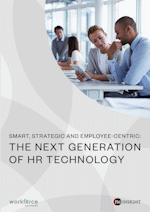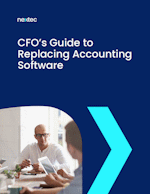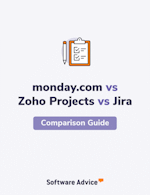Workforce Management Buyer's Guide
The Workforce Management Buyer's Guide helps organizations understand how to evaluate and select a WFM solution that improves productivity, controls labor costs, and supports compliance. It outlines key WFM capabilities and provides guidance on assessing needs and choosing a system that aligns with both current requirements and future growth.
Time and Attendance Buyer's Guide
Effective time and attendance management is essential for controlling labor costs, ensuring compliance, and improving workforce productivity, yet many organizations rely on outdated, error-prone systems. The Excelforce Time and Attendance Buyer's Guide provides a clear, step-by-step framework for evaluating, selecting, and implementing an automated solution that improves payroll accuracy, labor visibility, and employee engagement.
HR Trends and Priorities for 2026
Explore ADP's HR Trends and Priorities for 2026. Discover insights on AI, workforce planning, employee well-being, and regulatory changes that will shape the workplace of the future. Learn how to prepare your organization for success in 2026 and beyond.
The Risks of Trusting QuickBooks
The whitepaper argues that while QuickBooks may work for small or early-stage companies, it becomes a growing liability as organizations scale, exposing them to operational inefficiencies, data fragmentation, and unreliable financial reporting. It highlights eight major red flags - such as spreadsheet-driven workflows, limited revenue-recognition capabilities, weak audit controls, and lack of real-time visibility - that collectively lead to recurring errors, slow month-end closes, and poor decision-making. Through real customer examples, the paper illustrates how companies outgrowing QuickBooks often face challenges with multi-entity management, billing complexity, and inventory compliance, ultimately making a strong case for transitioning to a unified, scalable ERP solution like NetSuite.
The Next Generation of HR Technology
As the nature of work rapidly evolves - accelerated by the pandemic - employees, especially remote and deskless workers, expect employers to deliver flexible digital tools, streamlined processes, and clear communication, driving organizations to rethink HR's role; the blog highlights a PM Insight report that frames modern HR innovation in three pillars: performance, by automating administrative tasks (controlling labor costs and freeing HR to focus strategically); experience, by offering mobile, self-service tools that meet digital-native expectations and improve engagement; and intelligence, by applying AI and predictive analytics to derive actionable insights from workforce data, enabling proactive decision-making and better alignment between workers and organizational needs
HR Trends & Priorities Guide for 2026
The HR Trends and Priorities Guide shows that as 2026 begins, HR is navigating rapid technological change and rising expectations, with AI and automation driving modernization, efficiency, and data-driven decision-making. Leaders are focused on enhancing employee experience, attracting and retaining talent, and accelerating upskilling. Optimism is high, with most HR and finance professionals planning technology investments and expanding strategic HR roles. Success in 2026 will favor teams that integrate technology, prioritize workforce development, and use AI to build efficient, engaging, and future-ready workplaces.
A Comprehensive Comparison: HubSpot vs. Salesforce CRM
This guide compares HubSpot and Salesforce CRM platforms. HubSpot offers a simple, all-in-one solution with easy integration and low maintenance, making it ideal for small to mid-sized businesses. It provides robust support and scalability without added complexity. On the other hand, Salesforce is highly customizable and powerful but can be more complex and costly to implement, with reliance on third-party integrations and a more intricate setup. HubSpot is best for businesses seeking ease of use, while Salesforce is suited for large enterprises with more complex needs.
The Ultimate Guide to Inbound Marketing
This guide provides a comprehensive overview of how modern businesses can adopt the inbound marketing methodology to drive growth by attracting, engaging, and delighting customers rather than relying on traditional outbound tactics. It outlines key fundamentals—including developing buyer personas, mapping the buyer's journey, and crafting high-value content tailored to each stage—to create a strategic framework for converting website visitors into leads and nurturing them through to loyalty. Additionally, the guide explains how to design optimized conversion paths (calls-to-action + landing pages + thank-you pages), implement lead-nurturing campaigns, and harness marketing-automation tools to streamline the process. Ultimately, it underscores the necessity of aligning content, SEO, social media, and infrastructure in a measurable inbound strategy that lowers cost per lead and drives scalable, long-term business growth.
CFO’s Guide to Replacing Accounting Software
This guide for CFOs outlines why legacy accounting software often reaches its limits - struggling with scalability, visibility, forecasting, inventory management and data silos - and highlights how migrating to a purpose-built ERP system can deliver real-time analytics, integrated operational and financial workflows, and deep functionality. Drawing attention to clear signals - such as intensive manual workarounds, lack of production visibility or fragmented systems - the document explains how an ERP built can support growth, improve profitability and future-proof business operations. It then provides a structured framework for selecting the right solution and implementation partner so that finance leaders can confidently steer their company through a software replacement and onto a more strategic platform
Jira vs. Zoho Projects vs. Monday.com Comparison
Struggling to choose between Monday.com, Zoho Projects, and Jira? Our comparison guide highlights how each platform performs across usability, collaboration, automation, and pricing - so you can quickly see which best fits your team's workflow. Don't guess which tool is right - download the guide to make a confident, informed decision.










